US tariffs trigger volatile shipping rate swings: Xeneta


President Donald Trump’s sweeping US tariff hike on China and other trading partners in April continues to ripple through global container shipping, triggering wild swings in freight rates and supply chain disruptions across major routes.
In the wake of ‘Liberation Day’ tariffs, transpacific shipping demand plummeted, with carriers quickly redeploying capacity away from China–US trades towards North Europe and South America East Coast (SAEC) lanes. But a mid-May tariff truce between the US and China ignited a cargo rush, causing West Coast spot rates to surge 75 per cent and East Coast rates to jump 58 per cent in just two days (between May 31 and June 1).
As capacity swiftly returned to US routes, the oversupply drove rates down once again—by 58 per cent into the West Coast and 35 per cent into the East Coast since June 30. This cycle also distorted the normal price gap between coasts: the usual $1000 per forty-foot equivalent unit (FEU) spread widened to $2015 per FEU, with US West Coast spot rates dropping faster than East Coast equivalents, according to market intelligence company Xeneta.
The South America East Coast (SAEC) trade has felt severe aftershocks. As carriers pulled vessels to service the transpacific boom, SAEC spot rates soared from $1,890 per FEU on May 1 to a peak of $6,945 on July 16—up over 260 per cent. Compounding the issue, demand from Asia to SAEC hit record highs in May.
Now, as rates fall back in the US, capacity is once again shifting—this time back to SAEC to capitalise on the higher prices. This will pressure rates downward, illustrating how carriers inadvertently undercut their own gains by chasing higher-paying trades too aggressively.
Far East–North Europe trades also saw a surprising 78 per cent rate surge between May-end and July, with average spot rates now at $3,410 per FEU. While much of this is driven by labour strikes and low Rhine water levels hindering barge movements, tariff ripple effects also played a role. Carriers initially added record-breaking capacity to this corridor when pulling out of US routes in April, intensifying port bottlenecks just as inland disruptions peaked.
Looking ahead, rates into both US coasts and SAEC are forecast to continue falling through the rest of 2025—unless carriers sharply cut capacity or a new market shock arises. The short-term spike after the tariff truce proved unsustainable as shippers frontloaded inventories during the 90-day window, a strategy that can’t be repeated indefinitely.
Conversely, European shippers may face persistent upward pressure on contract rates due to ongoing North European port congestion, making it a key outlier amid falling global rates.
To weather such volatile freight swings, industry experts recommend index-linked contracts. These agreements anchor long-term pricing to prevailing market benchmarks, reducing the need for constant renegotiations during geopolitical or economic shocks. This model allows shippers and logistics partners to focus on service reliability and long-term supply chain resilience.
US tariff hikes by President Donald Trump continue to disrupt global container shipping, triggering volatile freight rates.
After a cargo rush post-tariff truce, spot rates soared, then slumped on US trades.
South America and North Europe lanes saw major ripples.
With rates likely to fall, experts urge index-linked contracts to manage supply chain risk.
Fibre2Fashion News Desk (HU)
